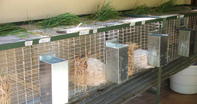
Here is a list of terms used in rabbit farming and an explanation for each of them.
Aggressive trait: An aggressive (wanting to bite and scratch) tendency that is carried from the parents to their young stock
Bedding: Grass, sawdust or shredded paper used to cover the cage floor, or to put in nest boxes
Bloat: A swollen gut caused by incorrect feeding
Breed Standards: A description of how a breed should look. All purebred animals have a breed standard by which they are judged
Bucks: Male rabbits
Catch Tray: A tray placed under a wire floor to catch manure and urine
Castrate: To remove testicles and thereby make the male infertile
Chop: Green feed, lucerne and hay that has been finely cut up
Coccidiosis: A bacterial disease that can kill rabbits. Happens most in rabbit cages that are not properly cleaned
Colony: A large run or cage in which several young rabbits can grow up together
Compost heap: A collection of all manure, bedding and plant material left to decompose and be used on the vegetable garden as a fertiliser
Concentrates: A mix of feeds that are balanced and put through a pellet-making machine. A good, but expensive way to feed rabbits
Consistent: All the same
Conception: The moment when a female falls pregnant
Cover: A term used to describe a mating
Does: Female rabbits
Double Tier: Cages layered on top of each other
Eragrostis: A very good grass that can be dried into hay
Feed containers: Dishes and systems used to supply feed to the cage
Foster: To take surplus babies from one doe and give them to another to raise
Genetics: The science of studying characteristics of a breeding stock
Genitals: Sexual organs
Green feed: Any vegetable or grass fed fresh
Hay: Grasses dried
Hay Ricks: A wire system used to hold hay for feeding
Haunches: The hind legs of a rabbit
Home consumption: Slaughtered to feed the family and not for sale
Hoppers: Automatic feed containers
Hutch: The cage in which a rabbit is kept
Hutch card: A record keeping system fixed to the cage
Immunity: Safe from catching a disease
Import: To bring in from another country or place
Indigenous: Animals that originate in the place where they live
Labour intensive: Requires a lot of labour to get right
Litter: A batch of baby rabbits from one mother
Loins: The muscle running down the spine of the rabbit where the hind legs join the body
Malocclusion: Broken or damaged teeth
Mammary glands: Teats that supply milk to babies
Mastitis: An infection in the mammary glands
Mating: Putting a male and female together to breed
Mentor: A guide or teacher
Myxomatosis: A killer disease that we do not have in South Africa
Nest box: A container in which the doe has her litter
Nipples: Part of the mammary system from which the babies drink
On Heat: Doe ready for mating
Palatable: Tastes good
Partition: A divider in a cage to make two spaces out of one
Pellets: Concentrated feed processed for easy management
Predators: Any animals that would like to kill and eat rabbits such as dogs, cats, snakes, rats
Progeny: Babies from one or a group of animals
Prolific: Can produce lots of babies
Roughage: Hay or green feed that is not in pellet form
Rump: Hindquarters
Sawdust: The dust and shaving from cutting wood
Scruff: Loose skin behind the neck
Sexing of babies: To separate males from females at weaning
Sleek: Strong, shiny and healthy animals
Stock: Your breeding animals
Stockman: A person who tends and understands his stock well
Teff: A grass usually fed as a very high quality hay
Territorial: Protective of its own space
Viral Haemorrhagic Disease: A killer disease not in South Africa
Vulva: Female genitals
Water nipples: Part of an automated water system from which the rabbit drinks
Weaning: Taking a litter of babies away from their mother